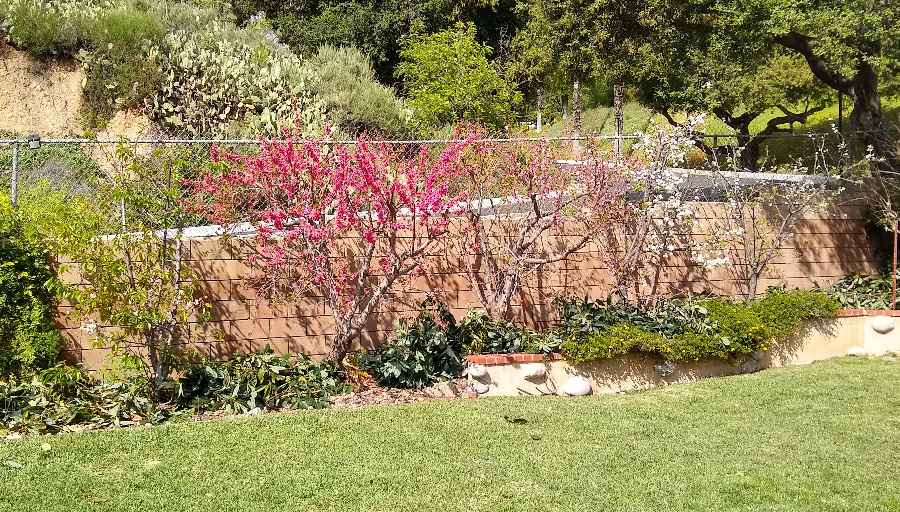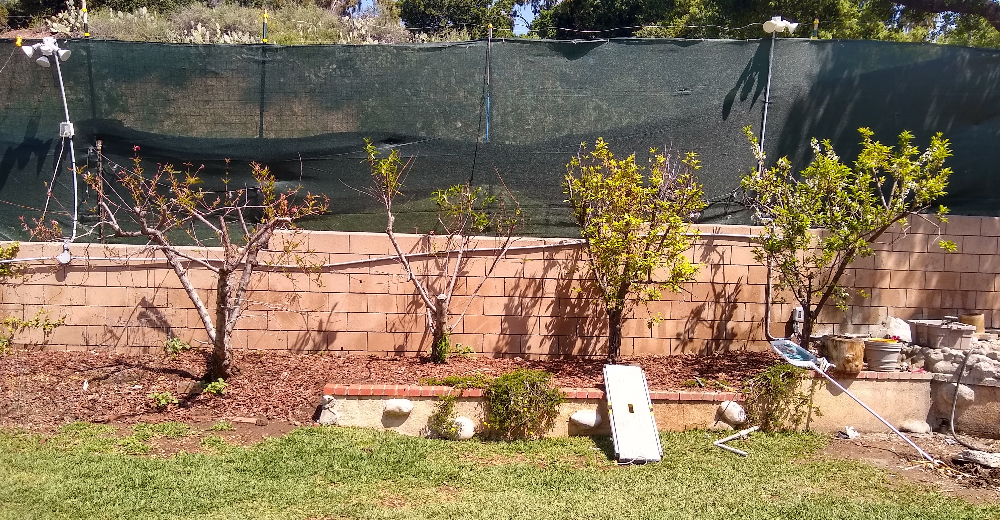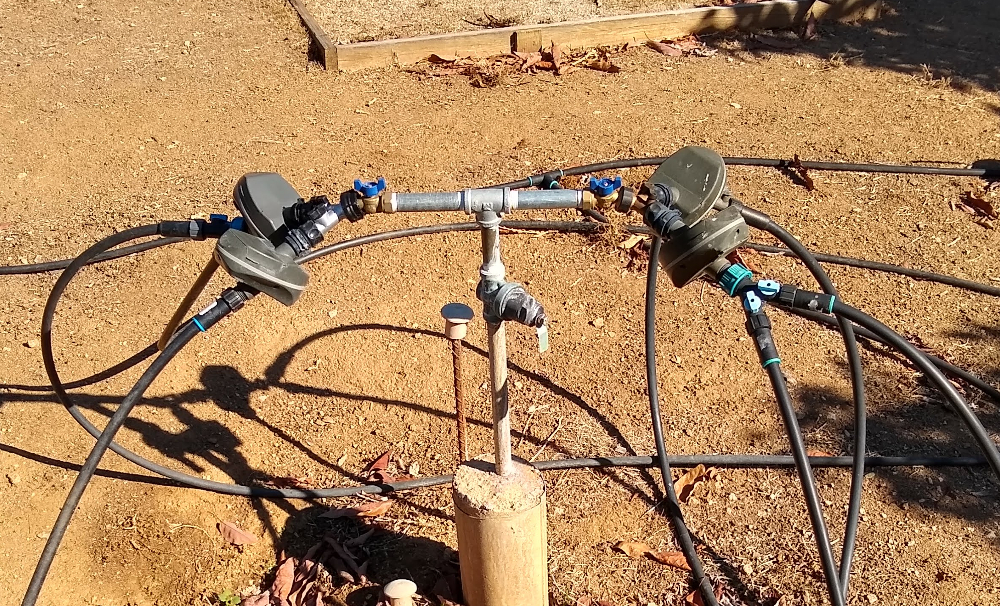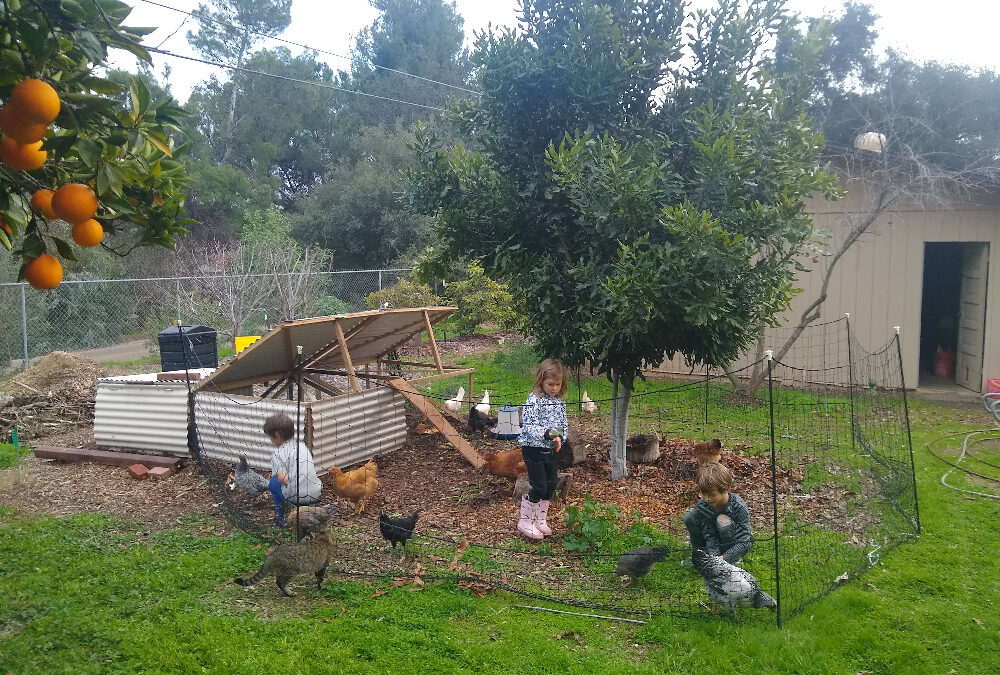Spring fever is in the air, and you might be tempted to take your food gardening to the next level. You might envision your garden becoming a backyard farm. I support you.
This week I joined the Master Gardeners in San Diego County to talk about backyard farming. Here I’ll share a few of the ideas I presented in that talk. I hope they can help you overcome some of the challenges that you are likely to encounter, challenges that I certainly have encountered.
Land challenges
Few of us have more land than we desire; most of us in Southern California are trying to squeeze an acre’s worth of plants into a quarter acre.
One way to fit more trees into a small space is to plant them closely. High-density planting of fruit trees can work, but you must be prepared to prune consistently and hard enough. If you don’t, you lose all fruiting wood down low.


(My posts on keeping deciduous fruit trees pruned small, avocados, and citrus.)
There are also various ways to mix vegetables into your fruit tree plantings that will maximize the use of ground space under your fruit trees and save space in the vegetable garden. I especially like adding vining plants like pumpkins, watermelons, and cucumbers under my fruit trees.
(My post on growing vegetables under fruit trees.)
Why have a compost heap and a chicken coop? Combine them by putting your chickens on a bed of wood chips and then giving your chickens scraps from the kitchen and garden. They’ll eat the scraps, poop on them, scratch them together with the wood chips, and create compost on the spot.
(“Chickens: my garden’s little helpers”)
Time challenges
As far as possible, I believe it’s important to include animals like chickens into a scaled-up garden. But if you don’t think you have the time or interest to care for animals, maybe someone else in your family does. In my family, it’s my son Miles who gets the greatest joy from caring for animals so he does many of the chicken chores, which are less like chores for him and more like fun. As far as possible, we should divide the work according to interests and natural inclinations.
Even though you can handwater a small food garden, automated irrigation is an essential time-saver for a large garden. And the technology does not have to be sophisticated or pricey. A single, inexpensive hose-end timer waters my entire vegetable garden, for instance.

From about May through October, the weather in Southern California is very predictable. Rare are the years with significant rain in any of those months so you can set a watering schedule to care for your plants’ needs through that period without over- or underwatering much.
How to figure out the watering schedule? That does take some trial and error, but you can get starting points from this cheat sheet that I created. Also, find watering tables for avocados here, and for citrus here.
Other challenges abound, but the benefits of a backyard farm are numerous. I love the clean and nutritious food that we’re able to produce for the family; I love spending time outdoors rather than behind a desk or a screen; and even though having an outsized garden makes taking vacations difficult, it is never boring when we’re home.
All of my Yard Posts are listed here.
Your Support keeps the Yard Posts engine running. Thanks!




So I have wanted to get back to you on our challenges with three years of a colder spring. It turns out the Honey bees only come out of the hives when it’s 58 degrees and above. Bumble bees come out at 50F. So I made a bumble bee hive. Very easy to do. The problem in my area Laguna Hills is we are colder in our micro climate. I have written to the city and was asking them to consider dedicated space for bees. https://www.alveole.buzz/cities/usa/urban-beekeeping-in-philadelphia/ It is happening in other cities. We recently lost two neighbors with bees, one too close to trails and another they bothered the chickens. So we will all have a bee problem soon enough if Spring continues to be colder. I have found the Reed avocado is the one to grow because it flowers in May here so it by passes the cold Spring. FYI Bumble bees love the ice plants–especially the yellow flowers–
Just yesterday I was out at sunrise harvesting avocados in a chilly morning fog and I noticed that there were no honey bees visiting the avocado flowers until the sun started breaking through and it warmed up. But yes, so many other kinds of bees and flies are active at cooler temps. In past springs, I have noticed bumble bees visitng my blueberry flowers at cooler times of day when honey bees are absent.
This spring, as I walk around my yard, I don’t see as many honey bees as last year. But I’m not worried. I see many native bees, as well as syrphid flies, all of which can accomplish lots of pollination. I love seeing bumble bees, and I’m glad you reminded me about them because I want to make some nesting habitat for them this year.
Good to hear your observation of the Reed avocado. I have also noticed the same.
In the last three years only the Reed has produced fruit. The situation is much dire than bees. My two Zutanos, blooms, no fruit, Hass –0 –three Fuertes–0–Mexicola grande 18 years old -0–Most of my trees are varying ages–Fuerte 25 years, one 7 years. I even planted seedlings two years of blooms on them –0 fruit. It’s downright depressing. I will have to start buying Reeds, I grafted one now to see if I can continue to get fruit. I have a very diverse yard, close to 50 fruit trees all types. Ten blooming trees zero fruit in all. The Reed has fruit on it now almost ready, so not yet blooming.
Our two most productive avocados last year are planted right next to the chicken coop. Lots and lots of fruit. I believe it is because of all the chicken poop bringing the flies.